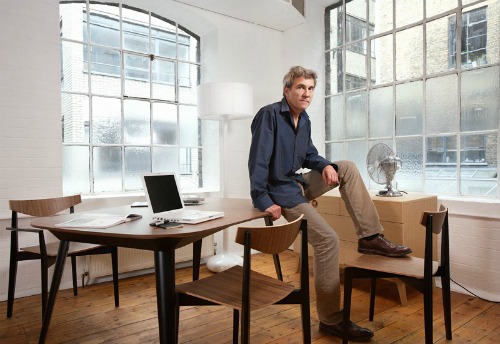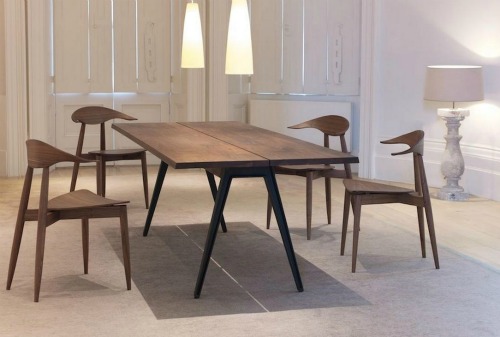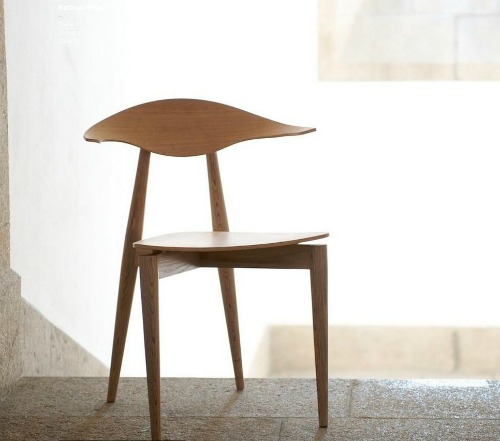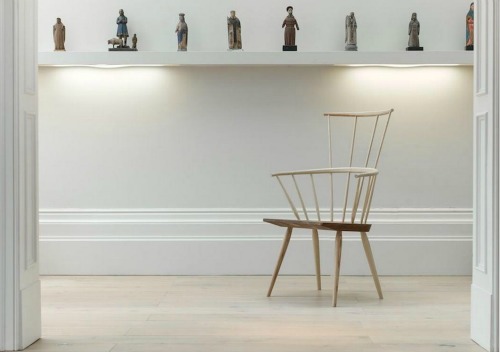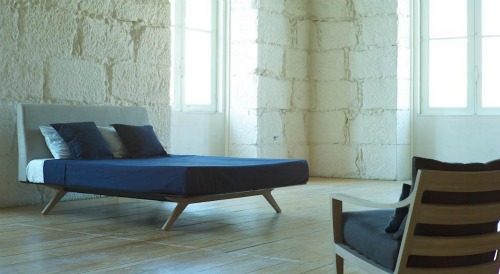An Exclusive Interview with International Designer Matthew Hilton
Award-winning British designer Matthew Hilton brought his design savvy to Boston when he spoke last Thursday night at Addo Novo design studio. After more than thirty years in the business, countless accolades, and experience working for some of the top furniture brands in Europe, Hilton has launched his own signature line with the Portuguese manufacturer, De La Espada. His streamlined pieces, made from materials including timber and cast-iron, reflect this designer’s down-to-earth personality.
Here Hilton shares some insight into his artistic process:
Tell me about your collaboration with De La Espada.
I’d always worked for other brands, and people would say, “This piece designed by Matthew Hilton.” Working for good furniture brands is a great way to learn but your creativity is constrained by the culture of each company. What’s more, I found it was difficult to produce a cohesive story or statement, which is quite frustrating as a designer.
So in 2007, I created my own line, manufactured in Sri Lanka and shipped to a trade fair, but the quality of the pieces was quite below standard. It was a real shock to me and I realized this was going to be tricky. In spite of that, I got a good reception at the trade fair—lots of press—people wanted to place orders, but I refused because I was so concerned with the sub-standard quality.
Then Luis from De La Espada suggested he make some things for me. Over the next couple months, this developed into a collaboration in which De La Espada does everything, apart from the design. Now I’m completely free. I have my own website, I’m free to build my own thing. It’s a very good relationship.
It changes all the the time, but functionality is always the starting point for a design. We think about how people will use each piece. We ask ourselves, how do we make something unique that people will want? How can we improve on what’s already out there? What can we do that hasn’t been done before? Or, what’s our take on it?
I don’t look at trade fairs very much or publications very much, but I look at stores and see what they’re putting out. I’m always trying to make real furniture that will get used, that people will and keep and use. I hope my designs will improve with age, so we use good quality hardware and long lasting materials.
The collaboration with De La Espada is exciting because I have so much freedom. I have to manage the range myself—I decide which pieces we’re going to make and how they’re going to be made, and so on. Price points aren’t exactly up to me, not completely, but I have a lot of autonomy.
What materials do you favor?
Well, solid timber’s fantastic for furniture, and timber in general works very well in this particular collaboration with De La Espada because they’re such experts in manufacturing with wood. But I like all kinds of things.
Natural materials—stone, wool, cotton—pretty much anything that comes out of the earth. We don’t cover up our materials, they’re left in their raw state as much as possible. So the wood is =oiled to preserve it, cast iron is just cast iron. It’s very straightforward.
I’m very, very conscious of aesthetics but not at the expense of functionality. I’m always balancing function, aesthetics, manufacturing, and price. I guess there are other things that you have to put in there, like ergonomics and transportation, but those four things are really key.
I don’t like plastics very much at the moment.
On entering Addo Novo, the “358 Different Trains Cabinet” really caught my eye. Could you tell me a little bit about that?
Yeah, we were trying to sort of ‘loosen up’ storage–find a way of storing stuff that isn’t just a box with a door on the front. And this is kind of a box with a door on the front, but it’s an open box, and the doors don’t close the whole space: you can play around with them. It’s very casual; you know the doors come off very easily, and it’s good fun.
You could say the most functional piece of storage is a box. And it is, but it’s also the most conventional–and it’s slightly dull–and we’re trying to do something that’s absolutely not that. It could be a room divider, it’s a multipurpose sort of thing. And you can play with it, which I really like.
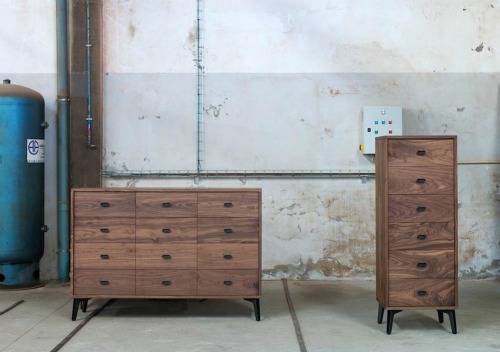
How did you choose the cabinet colors?
We selected those colors because they’re neutral—interesting but not too strong. I mean, they’re kind of safe, but because the piece isn’t that conventional I think it’s okay. It’s one of my favorites.
I wish I could build loads of different colors so if somebody wants bright red, they can have bright red. But that, logistically, and for transportation, and for stores, and for stocking stuff, just becomes a nightmare. You really have to make some decisions.
Any design advice for somebody who isn’t entirely sure on how to start designing a space of their own?
I think you should approach home design just as you approach what you wear—you’ve got to do what you want, and be yourself, enjoy your home and live comfortably.
But I do think it’s worth investing in good quality things, as with clothes. They last longer, you end up liking them longer, and you know they get better with age.
When I buy a new a coat, I spend as much as I can afford because it’ll last. Same with shoes. Buy yourself a good bed, a good couch, a good dining table…the essentials. Good quality basics lift everything.
This is your first visit to Boston, have you observed any trends in terms of design here?
I haven’t been here long, but I definitely see a New England thing. You know—restaurants with stick-back chairs, and those paints. In Britain, I call them national trust colors, historic paint colors used on houses and restaurants and bars and so on, olive green, and dark grey, and dark red. That’s quite strong here. It’s not particularly modern, but those things are useful; they’re good. It’s important to keep those things.
I don’t believe that modern design should replace everything. I refer to history a lot and I’m influenced by it a lot, and I understand why people want links to the past. It’s very nice to see.
